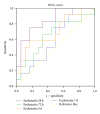Endostatin/collagen XVIII is increased in cerebrospinal fluid after severe traumatic brain injury
- PMID: 24089677
- PMCID: PMC3780551
- DOI: 10.1155/2013/402375
Endostatin/collagen XVIII is increased in cerebrospinal fluid after severe traumatic brain injury
Abstract
Recent studies have suggested that endogenous angiogenesis inhibitor endostatin/collagen XVIII might play an important role in the secondary brain injury following traumatic brain injury (TBI). In this study, we measured endostatin/collagen XVIII concentrations serially for 1 week after hospitalization by using the enzyme-linked immunosorbent assay method in the cerebrospinal fluid (CSF) of 30 patients with TBI and a Glasgow Coma Scale (GCS) score of 8 or less on admission. There was a significant trend toward increased CSF levels of endostatin after TBI versus control from 72 h after injury. In patients with GCS score of 3-5, CSF endostatin concentration was substantially higher at 72 h after injury than that in patients with GCS score of 6-8 (P < 0.05) and peaked rapidly at day 5 after injury, but decreased thereafter. The CSF endostatin concentration in 12 patients with an unfavorable outcome was significantly higher than that in 18 patients with a favorable outcome at day 5 (P = 0.043) and day 7 (P = 0.005) after trauma. Receiver operating characteristic curve analysis suggested a reliable operating point for the 7-day CSF endostatin concentration predicting poor prognosis to be 67.29 pg/mL. Our preliminary findings provide new evidence that endostatin/collagen XVIII concentration in the CSF increases substantially in patients with sTBI. Its dynamic change may have some clinical significance on the judgment of brain injury severity and the assessment of prognosis. This trial is registered with the ClinicalTrials.gov Identifier: NCT01846546.
Figures



References
-
- Pandya NM, Dhalla NS, Santani DD. Angiogenesis—a new target for future therapy. Vascular Pharmacology. 2006;44(5):265–274. - PubMed
-
- Sköld MK, Risling M, Holmin S. Inhibition of vascular endothelial growth factor receptor 2 activity in experimental brain contusions aggravates injury outcome and leads to early increased neuronal and glial degeneration. European Journal of Neuroscience. 2006;23(1):21–34. - PubMed
-
- Morgan R, Kreipke CW, Roberts G, Bagchi M, Rafols JA. Neovascularization following traumatic brain injury: possible evidence for both angiogenesis and vasculogenesis. Neurological Research. 2007;29(4):375–381. - PubMed
-
- Nag S, Takahashi JL, Kilty DW. Role of vascular endothelial growth factor in blood-brain barrier breakdown and angiogenesis in brain trauma. Journal of Neuropathology and Experimental Neurology. 1997;56(8):912–921. - PubMed
-
- Nag S, Eskandarian MR, Davis J, Eubanks JH. Differential expression of vascular endothelial growth factor-A (VEGF-A) and VEGF-B after brain injury. Journal of Neuropathology and Experimental Neurology. 2002;61(9):778–788. - PubMed
Publication types
MeSH terms
Substances
Associated data
LinkOut - more resources
Full Text Sources
Other Literature Sources
Medical

